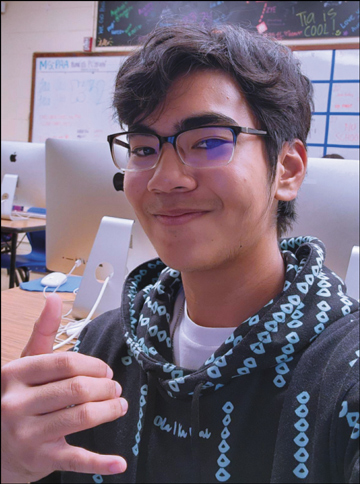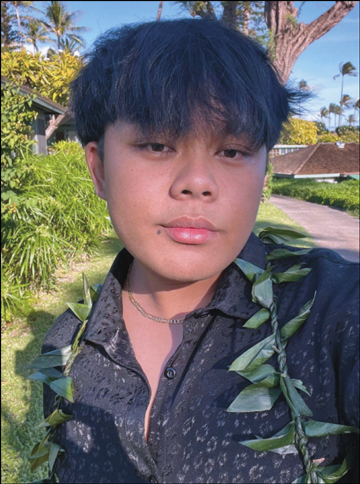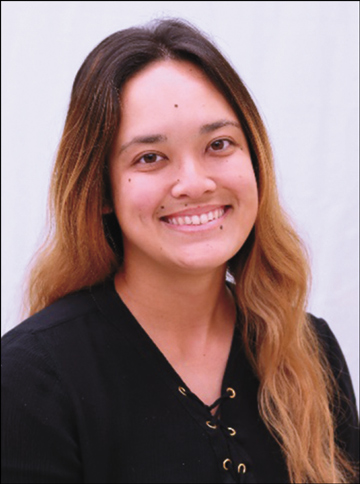
Beyond Taste
Jazmyne Faith Viloria | Maui High School, Class of 2023
As the golden bubbles glisten over the upward side of the lumpia wrapper, I rush to the stove, and the welcoming sizzles instantaneously make my mouth water. I reach for the tongs and flip the turon to reveal its crispy tan reflection. I gently tuck it into a foil wrapper to let it bask in all its sugary glory. The light emphasizes its hardened sugar dollops, the ends standing up with assertion, its heat transferring to my hand—munch. My brother impatiently chomps the turon and is now fanning his mouth, “It’s wor–worth the pain!” he breathly exclaims. With each Filipino dish’s delicious taste, there is an associated memory or meaning that makes the eater feel nostalgia and at home.


“When it came to a family gathering or celebration I bee-line to the halo halo,” explains Angelina Ancheta. As food starts correlating to happy times and events, it creates a new memory and feeling to the eater, “One of my nostalgic memories actually included me eating halo halo, me and my friends were all hanging out at Maui’s annual Barrio Fiesta. Viewing all the performances and walking around with a halo halo in hand made the day so much more enjoyable,” remembers Angelina. Similar to Angelina, Kainalu Bediamol, connects bibingka to family parties, “Every time I go to a family celebration, I can count on bibingka making an appearance in the dessert line.” Kainalu reveals his gravitation towards bibingka is because of his mom, “My mom asked if I ever tried bibingka before, I questionly responded back no and in the same second she pulled it off her plate and handed it to me. Bibingka became the first Filipino dessert I tried and I owe it to my mom.”

“My favorite Filipino dish are empanadas!” exclaims Charie Salacup. Although the dish’s crunchy outer shell and flavorful fillings makes it a favorite for most, for Charie she has a different reason, “Empanadas will always be my favorite because of its nostalgic smell and iconic look brings me back to my trip to the Philippines. As me and my parents passed empanada carts throughout Vigan, I would plead with my parents to buy one. I’d always appreciate when they buy me one and I would continue walking about with an extra snack in hand,” reminisces Charie. Connecting food to a family trip gives food a new story.


“I appreciate that she went out of her way to cook me arroz caldo as I was sick in bed,” expresses Jasper Bibat. Every time Jasper felt ill, his mom would immediately cook arroz caldo. At first he would associate it as a routine food, however, Jasper recognizes, “It became my comfort food, as the arroz caldo healed my throat, my heart became warm with appreciation for my mom.” Parents’ actions have the greatest impact on their children. For Jordyn Paa, her mother’s efforts in cooking Filipino cuisine became a core childhood memory, “I would always get excited when my mom cooked pork adobo.” Growing up Jordyn did not have much Filipino culture implementation throughout her daily life. Throughout childhood she was mainly exposed to her Portuguese culture, which led Jordyn to the conclusion, “My mom’s pork adobo became my intersection of Portuguese and Filipino culture. She would make it more vinegary which was similar to a Portuguese dish called Vinha D’Alhos. From this one dish it started my efforts in connecting with my Filipino culture.”
After hearing the stories of many, Filipino dishes hold much more than taste value. As Filipino dishes are introduced by parents, made a staple at family gatherings or form cultural connections, it becomes a core memory and holds a special meaning for each individual.
 Google® Is Not Everything is a monthly column authored by high school students. The title of the column emphasizes education is more than just googling a topic. Google® is a registered trademark. This month’s guest columnist is Jazmyne Faith Viloria, a Senior at Maui High School. She is a member of SaberScribes (Maui High’s journalism club), Historian of the Video Club and Team Captain of Blue Thunder, Maui High’s Robotics club. Jazmyne is in the ACOM Pathway at Maui High, focusing on videography and photography. In her free time, she sews and refashions old clothes, journals, edits photos/videos and loves to analyze lyrics in songs. She is the daughter of Ruth Sagisi and Rudy Viloria.
Google® Is Not Everything is a monthly column authored by high school students. The title of the column emphasizes education is more than just googling a topic. Google® is a registered trademark. This month’s guest columnist is Jazmyne Faith Viloria, a Senior at Maui High School. She is a member of SaberScribes (Maui High’s journalism club), Historian of the Video Club and Team Captain of Blue Thunder, Maui High’s Robotics club. Jazmyne is in the ACOM Pathway at Maui High, focusing on videography and photography. In her free time, she sews and refashions old clothes, journals, edits photos/videos and loves to analyze lyrics in songs. She is the daughter of Ruth Sagisi and Rudy Viloria.
